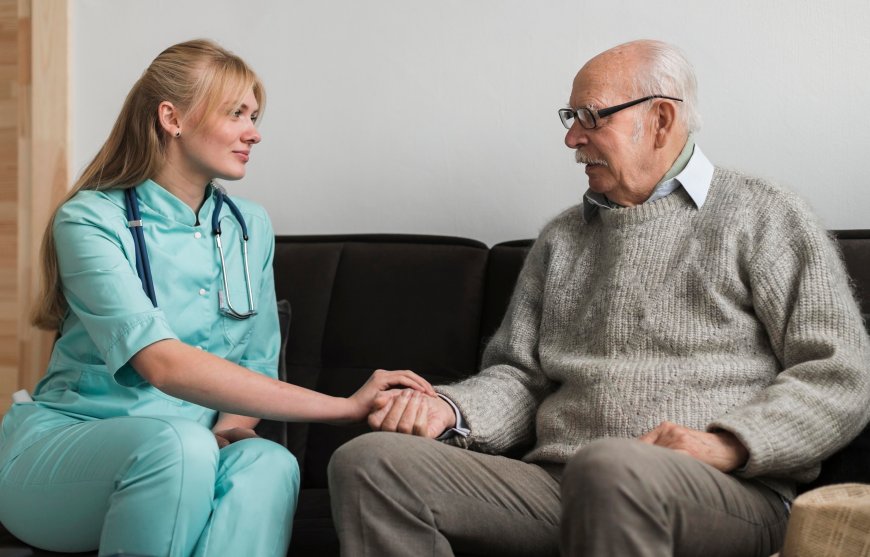Understanding Stroke Care: Why Immediate Action Matters
Stroke care begins the moment symptoms appear, and immediate action is often the difference between full recovery and lifelong disability. A stroke occurs when blood flow to the brain is interrupted, either by a clot (ischemic stroke) or a burst blood vessel (hemorrhagic stroke). Without oxygen-rich blood, brain cells begin to die within minutes, which is why time is the most critical factor. Quick recognition and prompt medical response can minimize long-term damage and even save a life. Many patients and families do not realize that treatment is most effective when delivered within the first few hours after the onset of symptoms. Understanding the urgency helps families respond without hesitation. Stroke care is not just about treatment but also about protecting brain health in the moments that matter most.
Key Symptoms That Should Never Be Ignored
Recognizing the signs of a stroke can empower families to act quickly. The most widely used method is the FAST acronym: Face drooping, Arm weakness, Speech difficulty, and Time to call emergency services. However, there are additional warning signs that are less well known but equally important. Sudden severe headaches, dizziness, vision loss in one or both eyes, or confusion can also indicate a stroke in progress. Some patients may experience numbness in the legs, difficulty walking, or trouble maintaining balance. Ignoring these signs can delay treatment, which may lead to greater brain damage. By learning to identify all possible symptoms, families can respond with confidence and urgency. Stroke care relies heavily on community awareness, which is why education about these warning signs is essential.
Emergency Stroke Care and First Response
When a stroke is suspected, emergency responders are trained to act immediately. Paramedics will assess symptoms, measure vital signs, and transport the patient to a hospital capable of stroke treatment. In many regions, specialized stroke centers are designated for rapid diagnosis and intervention. Upon arrival, the emergency room team conducts initial evaluations such as CT scans or MRIs to determine the type of stroke. The speed of this process is critical since ischemic strokes may require clot-busting drugs, while hemorrhagic strokes need different interventions. Stroke care at this stage is designed to stabilize the patient and prevent further brain injury. Families who call for help quickly give their loved one the best chance at recovery.
Stroke Care in Hospitals: What Patients Can Expect
Once admitted to the hospital, patients undergo a series of diagnostic tests to identify the type and severity of stroke. Imaging scans confirm whether the stroke is caused by a clot or bleeding, guiding the medical team toward the correct treatment plan. For ischemic strokes, doctors may use clot-dissolving medications like tPA if administered within a certain timeframe. In some cases, surgical procedures or mechanical clot retrieval may be necessary. For hemorrhagic strokes, care often involves surgery to relieve pressure on the brain or repair blood vessels. Continuous monitoring in an intensive care unit is common during the first 24–48 hours. Stroke care in hospitals focuses not only on treatment but also on stabilizing the patient’s overall health to reduce complications.
Rehabilitation as a Vital Part of Stroke Care
Recovery does not end after emergency treatment; rehabilitation is a critical step in regaining independence. Physical therapy helps patients rebuild strength, coordination, and mobility. Occupational therapy focuses on daily activities such as dressing, cooking, and self-care, enabling patients to adapt to new limitations. Speech therapy plays an important role for those who struggle with speaking, swallowing, or understanding language after a stroke. Rehabilitation often begins within days of the event, as early intervention has been proven to yield better outcomes. The process may continue for months or even years, depending on the severity of the stroke. Stroke care teams often include a combination of doctors, therapists, and support staff working together to design a personalized plan. Every milestone in rehabilitation represents progress toward a more independent life.
Emotional and Psychological Support in Stroke Care
While physical recovery is vital, emotional health is equally important in the journey of stroke care. Many patients experience depression, anxiety, or frustration as they adjust to new challenges. Caregivers and family members often face emotional strain as well, especially when daily routines shift drastically. Counseling and therapy can help patients manage these feelings, while support groups provide encouragement and connection with others facing similar struggles. Maintaining mental well-being improves motivation, which directly influences physical recovery outcomes. Family involvement also strengthens emotional resilience, as loved ones provide comfort and stability throughout the healing process. Addressing emotional needs ensures that stroke care is holistic and supportive rather than purely medical. When both body and mind are cared for, recovery is more sustainable.
Preventing a Second Stroke Through Lifestyle Changes
One of the most important goals of stroke care is preventing a recurrence. Lifestyle changes play a major role in lowering the risk of another stroke. Managing blood pressure, cholesterol, and diabetes is crucial since these are leading contributors to stroke risk. A balanced diet rich in fruits, vegetables, lean proteins, and whole grains supports cardiovascular and brain health. Regular exercise, even in the form of light daily movement, helps improve circulation and strengthens the body. Doctors may prescribe medications such as blood thinners or cholesterol-lowering drugs, and adherence to these treatments is essential. Regular medical checkups allow healthcare providers to track progress and make adjustments as needed. By making these changes, patients significantly improve their long-term health and reduce the likelihood of another stroke.
Long-Term Stroke Care at Home
After leaving the hospital, patients often require ongoing care at home. Making the home environment safer is a priority, which may include installing grab bars, removing trip hazards, or adjusting furniture for easier mobility. Establishing routines that support independence helps patients maintain dignity while recovering. Caregivers play an essential role by assisting with daily tasks, monitoring medications, and encouraging rehabilitation exercises. However, caregiver burnout is a real concern, and support systems should be in place to share responsibilities. Stroke care at home also benefits from incorporating technology, such as telemedicine check-ins or monitoring devices. With proper planning and support, home-based care allows patients to recover in a familiar and comfortable environment. Families who prepare well can help loved ones thrive beyond the hospital setting.
Advancements in Stroke Care
The field of stroke care is evolving rapidly, offering new hope to patients and families. Mechanical thrombectomy, a minimally invasive procedure, allows doctors to remove blood clots with precision and has shown remarkable success when performed quickly. Advanced imaging techniques now provide more accurate and faster diagnosis, ensuring patients receive the right treatment without delay. Telemedicine has transformed stroke care by allowing doctors to evaluate patients remotely and make life-saving decisions in areas without nearby specialists. Research into neuroplasticity is shedding light on the brain’s ability to rewire itself, offering exciting possibilities for long-term recovery. Clinical trials are also exploring new medications and therapies aimed at reducing brain damage and accelerating healing. These advancements highlight how stroke care continues to progress, giving patients better outcomes and greater quality of life.
Frequently Asked Questions (FAQ)
Can strokes be prevented completely?
While not all strokes can be prevented, adopting a healthy lifestyle and managing medical conditions significantly lowers the risk.
How long does stroke recovery usually take?
Recovery varies widely depending on the severity of the stroke, but many patients show progress within months and continue improving for years.
Is rehabilitation effective for older adults?
Yes, rehabilitation benefits people of all ages, including older adults, by improving mobility, strength, and overall independence.
What foods help with brain recovery after a stroke?
Nutrient-rich foods such as leafy greens, berries, nuts, whole grains, and omega-3 fatty acids support brain health during recovery.
Can someone live independently after a major stroke?
With the right stroke care, rehabilitation, and support systems, many patients regain independence, though the level varies by individual.











